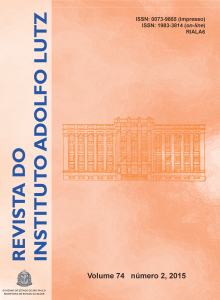Abstract
From the soya beans are obtained various by-products such as flour, meal, textured protein and oil, which are regularly used in food formulations such as cookies, breads, chocolates, among others. During the food processing, the soya structure might be changed, and turning into hard to perform the histological identification of this vegetable in the food products. This study aimed at identifying the histological characteristics of different soy sub-products. Textured soy protein, defatted soy protein, soy-isolated protein and concentrated soy protein samples were provided by a soybean processor industry. These samples were investigated by means of histological analysis, according to the Official Methods of the Instituto Adolfo Lutz for detecting the presence of the characteristic histological elements. Among the four analyzed sub-products, the isolated soy protein only showed no characteristic histological elements. The concentrated soy protein showed the lowest amounts of histological elements in relation to the textured soy protein and the defatted soy protein. These findings will contribute to the soya-based products analyses concerning their composition, in order to identify the potential fraud or contamination.References
1. Associação Brasileira das Indústrias de Óleos Vegetais – ABIOVE. Sustentabilidade do complexo soja: reflexos da política econômica. [acesso 2015 Fev 28]. Disponível em: [http://www.abiove.org.br/site/_FILES/Portugues/25072013-105434-37._sober.pdf].
2. Carvalho LC, Ferreira FM, Bueno NM. Importância econômica e generalidades para o controle da lagarta falsa-medideira na cultura da soja. Enciclopédia Biosfera, Centro Científico Conhecer [Internet]. 2012;8(15):1021-34. Disponível em: [http://www.conhecer.org.br/enciclop/2012b/ciencias%20agrarias/importancia%20economica.pdf].
3. Ministério da Agricultura, Pecuária e Abastecimento - MAPA. Soja. [acesso 2015 Fev 28]. Disponível em: [http:www.agricultura.gov.br/vegetal/culturas/soja/saiba-mais].
4. Juhász ACP, Pádua GP, Wruck DSM, Favoreto L, Ribeiro NR. Desafios fitossanitários para a produção de soja. Inf Agropec.2013;34(276):66-75.
5. Serviço Brasileiro de Respostas Técnicas - SBRT. Dossiê Técnico: Produtos de soja [acesso 2015 Fev 28]. Disponível em: [http://sbrt.ibict.br/dossie-tecnico/downloadsDT/Mjg=].
6. Menezes Junior JBF. Soja: origem, composição química, valor nutritivo e aplicações diversas. Rev Inst Adolfo Lutz.1961;21:33-56.
7. Rocha RS. Avaliação de variedades e linhagens de soja em condições de baixa latitude [dissertação de mestrado]. Teresina (PI): Universidade Federal do Piauí; 2009.
8. Esteves EA, Monteiro JBR. Efeitos benéficos das isoflavonas de soja em doenças crônicas. Rev Nutr.2001;14(1):43-52. [DOI: 10.1590/S1415-52732001000100007].
9. Behrens JH, Silva MAAP. Atitude do consumidor em relação à soja e produtos derivados. Ciênc Tecnol Aliment.2004;24(3):431-9. [DOI: 10.1590/S0101-20612004000300023].
10. Felberg I, Antoniassi R, Deliza R, Freitas SC, Modesta RCD. Soy and Brazil nut beverage: processing, composition, sensory, and color evaluation. Ciênc Tecnol Aliment.2009;29(3): 609-17. [DOI: 10.1590/S0101-20612009000300024].
11. Jaekel LZ, Rodrigues RS. Effect of a soybean and rice beverage on the lipid and glycemic metabolisms in hamsters. Ciênc Agrotec.2011;35(6):1211-7. [DOI: 10.1590/S1413-70542011000600023].
12. Badger TM, Ronis MJJ, Hakkak R, Rowlands JC, Korourian S. The health consequences of early soy consumption. J Nutr.2002;132(3):559S-65S.
13. Marson LP. A produção de derivados da soja e sua aceitação pelo mercado consumidor [monografia]. Bento Gonçalves (RS): Instituto Federal de Educação, Ciência e Tecnologia do Rio Grande do Sul; 2010.
14. Brasil. Ministério da Saúde. Resolução RDC nº 268, de 22 de setembro de 2005, Aprova o regulamento técnico para produtos protéicos de origem vegetal. Diário Oficial [da] República Federativa do Brasil. Brasília, DF, 23 set. 2005.
15. Winton AL, Moeller J. The microscopy of vegetable foods. 1st ed. London: Chapman & Hall Ltd; 1906.
16. Gassner G, Hohmann B, Deutschmann F. Mikroskopische untersuchung pflanzlicher lebensmittel. 5 Auflage. Gustav Fischer Verlag: Stuttgart; 1989.
17. Rodrigues RMM, Atui MB, Correia M. Métodos de análise microscópica de alimentos: isolamento de elementos histológicos. Vol. I. São Paulo: Letras & Letras; 1999.

This work is licensed under a Creative Commons Attribution 4.0 International License.
Copyright (c) 2016 Instituto Adolfo Lutz Journal
